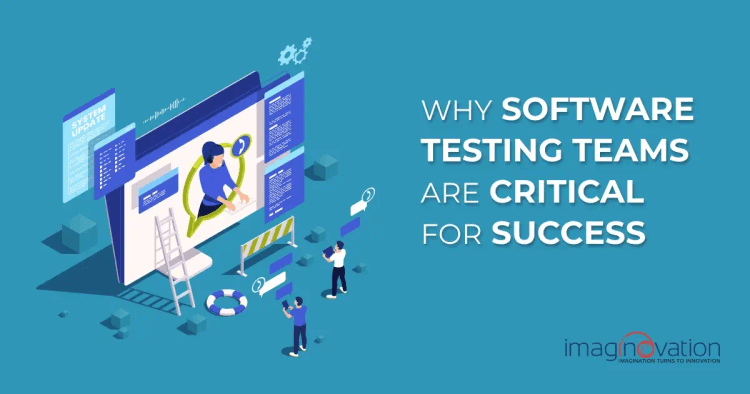Catastrophic software errors can strike fear into the heart of any business leader. The errors during launch or post-launch can be incredibly expensive, and to top it all—they can dent your brand image. It's no wonder that software testing is critical to an outstanding product.
The software testing industry is responsible for ensuring quality, reliability, and functionality in applications and systems. The statistics highlight the view, with the global software testing market projected to hit a whopping $109.5 billion by 2027.
The figures speak volumes about how focusing on the software testing teams can help deliver high-quality products. Tag along! In this article, we will look at why software testing teams are critical for your product's success.
The Role of Software Testing Teams
When it comes to the Software Development Life Cycle (SDLC), software testing is a critical component. The transformative journey to the success of a product relies on the software testing team playing a vital role in delivering high-quality products to a global audience. Since the software testing team comprises domain experts, it will help to look at the structure of the testing team. Further, let's look at the roles and responsibilities of the team.
1. QA Lead
The QA team lead is critical to any development team and is the most essential testing team member. They are responsible for ensuring that the QA for all the projects in your organization runs seamlessly. It is also vital for the QA Lead to know the various test-program concerns, which include the test environment and data management, trouble reporting and resolution, etc. Moreover, they also need to mentor and train the team.
Key responsibilities:
- Kickstarting projects and creating testing plans for any given project
- Overseeing all aspects, from planning to execution
- Acting as a PoC for departmental interaction
- Providing feedback and suggestions to the developers
2. Test Lead
Test leads are responsible for managing the organization’s team of testers. They also ensure that project deadlines are met and coordinate the test activities. Test leads have a clear understanding of the varied test-program issues, such as test design and development and test data management. Their skills in delegating tasks and resolving conflicts are exemplary and vital to the project's success.
Key responsibilities:
- Offering technical expertise related to the test program and being accountable for the project’s strategies and testing efforts
- Validating and ensuring the quality of the final software product through testing requirements such as testability, test design, script, test automation, etc.
3. Test Engineers—Usability Test Engineers, Manual Test Engineers, Automated Test Engineers
When it comes to test engineers, they develop test cases and prioritize testing activities. Further, they are responsible for executing all the test cases and designing test suites. The manual test engineers understand the GUI design and its standards well, and automated test engineers are great at designing efficient test suites and working with test tools.
Key responsibilities
- Designing the usability testing scenarios
- Manually executing the test procedures
- Attending test procedure walk-throughs
4. Network Test Engineer
A Network Test Engineer has a high level of proficiency in numerous technical skills. They are responsible for designing, executing, and automating tests of network hardware and software, ensuring high security and performance standards.
Key responsibilities
- Performing network, database, and middleware testing
- Developing test cases and load and stress test designs
5. Test Library and Configuration Specialist
The team member is a specialist who must be proficient in database and administration. They must also have a good know-how of programming languages and database technologies. Their responsibilities are to focus on the unique needs of each project and create, manage, and update test scripts, accordingly.
Key responsibilities
- Managing and maintaining the test-script change
- Creating and upholding test builds, wherever required
6. Tester
Software testers meticulously verify the software, ensuring no errors or bugs before launch. They analyze the software’s usability, functionality, performance, etc., and help deliver a top-notch product.
Key responsibilities
- Designing the testing scenarios for usability testing
- Creating test cases, test designs, and test-product documentation
Table 1: Snapshot of the roles and responsibilities of the software testing team members
| Software testing team member role |
Primary responsibilities |
Salary drawn in the US and Canada (approx. max range / per year) |
|---|---|---|
| QA leader |
Responsible for managing all the testing activities from planning to execution |
USA – $104,000 Canada – CA$97,000 |
| Test lead |
Typically, it defines quality metrics, develops testing procedures and test strategies |
USA – $92000 Canada – CA$105,000 |
| Manual test engineer |
Highly proficient in designing test suites and various testing techniques and can identify defects to ensure quality standards |
USA – $100,970 Canada –CA$71239 |
| Usability test engineer |
Implementing usability testing methods and tools and ensuring that the product or service meets the usability standards and requirements |
USA – $102,672 Canada –CA$79629 |
| Automated test engineer |
Specialist in automating various systems and identifying and eliminating errors in their work |
USA – $107,000 Canada – CA$85,000 |
| Network test engineer |
Designing, executing, and automating tests of network hardware and software to ensure that they meet performance and security standards |
USA – $91,000 Canada –CA$83,994 |
| Test library and configuration specialist |
Typically, needs to have good knowledge of database and administration skills and primarily focuses on creating, managing, and updating test scripts, mapping the specific needs of each project |
USA – $68827 Canada – CA$60425 |
| Tester |
Follow test plans, execute test cases, and report defects |
USA – $87,000 Canada – CA$81,000 |
Benefits of Having a Software Testing Team
Why are many organizations choosing to have a dedicated testing team? Here’s a quick roundup of the most significant reasons.
- More objectivity: The testing team can reduce biases and act as an impartial party to evaluate the software critically using analytical skills to identify and report defects.
- More cost savings and time: A dedicated testing team can help lessen the costs of poor quality, including any defects, rework, errors, or failures. They also help to deliver the products more efficiently, reducing the testing cycle time.
- Improved test coverage: The team can offer better test coverage and design and execute tests that touch on many facets, including usability, functionality, security, and accessibility.
- Increased security: Another crucial point is the team bringing forth well-tested and reliable products.
- Improved quality: They can ensure that the specific product comes to life by prerequisites, bringing value and offering the best satisfaction to the customers.
- Faster time to market: The testing team can help achieve faster delivery of software products through test automation and parallel testing.
- Reduced risk: They can help to minimize the chances of critical failures that could hamper or dent the company’s reputation or finances.

Undoubtedly the software testing team can help deliver a high-quality product. However, there are many types of software testing so which type can help your software product? Here’s a peek:
- Manual testing: Manual testing offers you human insight and adaptability. Manual testing is practical when you need more flexibility in your operations and the projects are short-term. Plus, it's more practical when the test cases are run once or twice and not frequently.
- Automated testing: Automated testing will help you with achieving scalability and efficiency. It's more practical to opt for automated testing when the test cases are run repeatedly over a long period. The chances of errors are eliminated due to computer-based testing. Furthermore, experts predict the automation testing market size will grow at a CAGR of over 16% in the period from 2021 to 2027.
- Functional testing: Functional testing verifies the functionality of a software system or application. It ensures that the system meets specified functional requirements and the intended business needs. The goal is to evaluate if the system matches the features, capabilities, and interactions with different components.
- Unit testing: It’s easy to catch issues early with Unit testing, as it can help verify if the modules or components are functioning as per prerequisites.
- Integration testing: With integration testing, one can ensure proper data flow because there is a check of interactions between integrated components or systems.
- Usability testing: The testing type can help identify issues related to navigation or workflow and, from an end-user perspective, evaluate ease of use for the software product.
- Security testing: It helps identify vulnerabilities that could be critical for secure software and avoid any exploitation or data breach.
- System testing: It helps to test end-to-end workflow and validate if the system meets requirements.
- Performance testing: The testing type helps identify scalability, speed, and reliability bottlenecks under expected load.
- Non-functional testing: When it comes to the non-functional requirements of the application, non-functional testing can help with verification. The techniques include compatibility testing, endurance testing, load testing, etc. The testing time helps to improve performance and the overall user experience of the software product.
The Cost of Skipping Software Testing
Picture this: you've poured in countless hours ensuring you meet all the prerequisites for the software product. You’ve also been meticulous about perfecting your code. You're now almost sure that you can skip testing. It could save you time, right? No! Cutting down on software testing has massive hidden costs down the line, which could be a huge snag. After all, you don't wish to have discontented customers, poor performance, or damaged company reputation.
Potential direct and hidden costs: Business leaders must avoid rushing to release products. The rush to release can incur hidden expenses. For instance, a bug that comes up thereon, it will be more costlier to fix it later than if you choose to address it earlier in the development and design phase. Moreover, correcting post-delivery is nearly four times as expensive if you find bugs and errors during development.
Impacts bottom line and customer satisfaction: A poorly tested software product can lead to a buggy app, which can impact customer satisfaction. End-users can complain and even give negative feedback, which can hamper your brand image and affect your bottom line.
Raises security breaches and data losses: Due to skipping the software testing phases, there could be far-reaching threats of security breaches and data losses. The vulnerabilities in source code can make software susceptible to attacks. Furthermore, there could be unauthorized access to sensitive information that could go beyond financial damage and impact the trust among all your stakeholders.
Increases financial implications: Inefficient or insufficient testing often goes beyond fixing bugs. The manifest has hidden expenses. For instance, there is an increase in the overall development costs and product release delays. Of course, one can understand the direct monetary impact. However, since the developer gets involved in addressing bugs or errors that come up post-delivery, it spells an indirect cost. The cost is associated with missed opportunities for innovation, where the developer could utilize the same time focusing on bringing in improvements or new features.
Missed market opportunities: Insufficient software testing or skipping it can slow down the time to market, giving competitors an opportunity to gain a competitive edge.
Unmet compliance obligations: Inadequate or insufficient testing can lead to compliance failures, as many regulations require proof of quality processes and secure software.
The Impact of Software Testing on Business Success
Picture this: your favourite app is constantly crashing, or the healthcare app is giving out a misdiagnosis, making the users' medical conditions worse. All such scenarios are disastrous and can be prevented through thorough software testing.
Software testing adds overall value and boosts customer satisfaction. It plays a pivotal role in guaranteeing a product’s reliability and stability. As the software product is subjected to various test scenarios, it helps reduce risks, errors, crashes, or malfunctions.
The UX is more seamless and intuitive, which leads to higher user satisfaction with usability testing and feedback collation. Furthermore, software testing helps deliver a top-notch quality product, which helps build trust and credibility among users and stakeholders. It also helps to adhere to security standards, protect sensitive data, and safeguard the business from potential legal and financial consequences.
Best Practices for Top-Notch Products
- Defining the scope and testing goals: Before one starts with testing, it will help to have a clear idea of what needs to be achieved and what needs to be covered. A well-defined testing plan will help you prioritize and focus your efforts and resources on the most relevant aspect.
- Selecting the most relevant testing tools and methods: Once the testing goals and scope are set, you must verify and validate your software. It will help you choose the right testing tools and methods, which can help you optimize your testing process.
- Cross-platform testing: Testing the software product across different platforms and devices will help check the compatibility and interoperability with other software products, apps, or systems. Thus, one must plan for tests on various operating systems, resolutions, screen sizes, or hardware configurations.
- Adhere to the best practices: It pays to test early and at every phase of the SDLC for the software product. Thus, prioritize and focus on the most critical and risky areas of the product. Plus, it is vital to test in scenarios that simulate real-world conditions.
- Evolve to be future-ready with trends in Software Testing: The software testing cycle is evolving rapidly, and it will help to delve into the emerging trends. Technologies such as AI, ML, and IoT can help save time and resources and ensure that you can seamlessly integrate new code. Modern technologies are vital for business success and can help you deliver excellence in every technological solution.
Wrapping Up
Errors made by humans can lead to catastrophic software failures. Thus, catching bugs and errors early is critical to your business's success. Your software testing team is a vital component that can help you achieve success. If you don't have an in-house team, partnering with a proficient expert such as Imaginovation can help you seamlessly work towards delivering a high-quality software product. Get ready to enjoy a competitive advantage!
Transform Software Testing with Imaginovation
Are you ready to architect phenomenal software products of top-notch quality? Our tech-savvy team can walk you through the entire software testing process, trends, and best practices.
We are an award-winning software development company in Raleigh with splendid experience incorporating quality assurance and software testing to give you a competitive edge.
Ready to build an app, but not sure where to start?
We've got you covered. Click the button below to get started.





